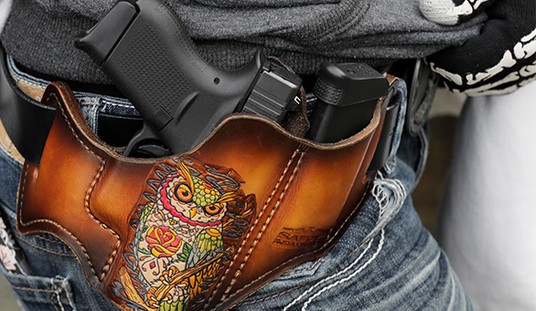For many there is no debate over choosing a personal defense handgun. Any discussions of preferred weapons start and stop with John Browning’s .45 ACP 1911. A few years ago, Sig Sauer made the decision to enter the ever burgeoning and fertile US 1911 pistol market. The initial entry was a full-size 1911 that earned a reputation as a well made, accurate, reliable 1911– no surprise to anyone familiar with other Sig Sauer handguns. Sig Sauer is often more associated with their great line up of double/single action handguns rather than the quintessentially American 1911, but the company quickly realized that a compact 1911 design would attract even more consumers with concealed carry laws expanding across the majority of US states.
I certainly appreciate the 1911’s history and proven performance track record on the battlefield and street. The 1911’s slim profile wrapped around the potent .45 ACP cartridge makes it ideal for concealed carry, especially with inside-the-waistband carry techniques. Someone who is a practitioner of concealed carry quickly realizes that grip length, overall weight, and width of a pistol are the key defining parameters for discrete carry handguns. However, I personally have not had much success with finding a true compact concealed carry 1911. Numerous attempts at testing 3.5" barreled (or smaller) Officer frame size 1911s have left me disappointed in terms of reliability. My attempts at using a Commander-sized 1911 with 4"to 4.25" barrels and full-size grip frames inevitably found me returning to my full-size 1911 with a 5" barrel. Sig Sauer’s 1911 RCS entry into the compact 1911 market gave me the impetuous for another attempt to find a 1911 for concealed carry.
Sig Sauer decided to combine an Officer-sized grip frame with a Commander-sized 4.25" barrel/slide length in the 1911 RCS Two-Tone model. While Sig Sauer is not the first manufacturer to do this, the RCS caught my attention with its aesthetics. The shorter, compact Officer-sized grip will print less under a cover garment than a full-size grip would, and the Commander-length slide provides the optimum mix of sight radius, concealment, balance, and reliability. The RCS measures 7.7" long, 4.75" high, and weighs 30 ounces unloaded.
 |
The RCS’s performance-enhancing features further solidified my resolve to give the pistol a try. Most compact 1911s with Officer-sized grip frames come with magazines holding six rounds. Sig has equipped the RCS with magazines capable of seven round capacity. Kudos should be given to Sig Sauer for making the higher capacity magazines standard with the RCS. The RCS is a Sig Sauer Custom Shop handgun and benefits from Sig’s Anti-Snag treatment, which dehorns sharp angles that could cause discomfort when carried for extended amounts of time or snag on clothing when drawn from cover. Novak night sights compliment the RCS’s intended role as a concealed carry weapon. The 25-lpi checkered front strap and mainspring housing at 20-lpi allow for a solid grip when drawing and firing under stress. The RCS’s match grade barrel and trigger combined with hand-fitted slides and frames insure maximum reliability and performance.
Sig Sauer 1911’s are distinctive in appearance with raised panels machined into the slide flats and the side flats themselves extending upward more than typically seen on other 1911s. Custom slim profile Rosewood grips complete the RCS Two-Tone package.
The Sig Sauer RCS’s trigger pull measured 4.5 pounds. I used Black Hills, Hornady, Winchester, and Wolf ammunition for my range testing and evaluation. The RCS impressively handled all brands, bullet types, and weights with equal aplomb.
RCS ergonomics and handling characteristics are quickly appreciated and make a user understand why the 1911 is a legend. Even under the induced stress of drawing against a timer and engaging multiple targets, the beavertail and manual safety were always positively engaged. The short grip frame and relative light weight of the RCS made recoil more of a factor versus a full size 1911, but in no way unmanageable. For me, the reduced size and weight of the RCS is far more beneficial for concealed carry.
Significantly, I experienced no malfunctions with the Sig Sauer RCS while test firing over 700 rounds during range visits used to evaluate the RCS for this article. Loads fired spanned 185gr to 230gr, with both hollowpoints and FMJ bullet types tested. Testing consisted of strings of fire against steel plate racks and popper targets at 7, 15, and 25 yards. I rarely bench test pistols for accuracy due to reliability and quick engagement of targets being paramount in a self defense handgun. However, I could not resist with the RCS being advertised as having a match grade trigger and barrel. The Sig Sauer RCS did not disappoint, regularly producing 2"-3" groups at 25 yards. This rivals full-size Match 1911s.
As alluded to earlier in the article, I have not had the most positive experiences in terms of reliability with compact 1911 designs over the years. I attribute the RCS’s reliability to Sig Sauer quality and the incorporating of a Commander-length slide in its design, which allows for a bushing and recoil spring configuration as originally designed by Mr. Browning. This also includes not using a full-length guide rod inside the recoil spring. This allows for field stripping without having to resort to a bushing wrench, and allows for easier press checks to verify if a round is chambered in the RCS. The Sig Sauer RCS does deviate from the classical 1911 design in the use of an external extractor.
Even with the distinctive Sig Sauer flat slide design, I had no issue with the RCS fitting holsters designed for the 1911. Specifically, I used a BlackHawk Serpa for much of my range work. When carried concealed, I used a Comp-Tac Victory Gear paddle holster, BlackHawk CQC Inside-the-Waistband, or BlackHawk Check Six model. All are comfortable, but the Comp-Tac paddle holster is the way to go if weather and dress allow. The Comp-Tac paddle holster remains secure on the belt and the RCS is retained with a pressure point around the trigger guard. Its open top design allows quick access. Remember the defender is reacting to an attack and must overcome the reactionary curve. The paddle allows a user flexibility in putting on and taking off the holster without having to "undress." A fact of life for civilian carry is that there are places you can not go with your firearm. The on/off ease of the Comp-Tac paddle holster is much appreciated when having to dismount your weapon into a lock box or other means of storage.
The Sig Sauer RCS’s performance has revived my interest in the compact 1911 as a viable concealed carry handgun. There are many other weapon models available on the market, but none exceed the capability of the natural handling, reliable 1911 chambered in the .45 ACP. Anyone contemplating concealed carry would do well to consider the Sig Sauer line-up of 1911s, especially the RCS. The RCS’s performance combined with 1911 nostalgia is difficult to resist when pondering a concealed carry handgun.
Photo by Keith Kilmer
Note from the Editor:
Want more concealed carry information? Click here for your free email copy of "The Armed American".








Join the conversation as a VIP Member